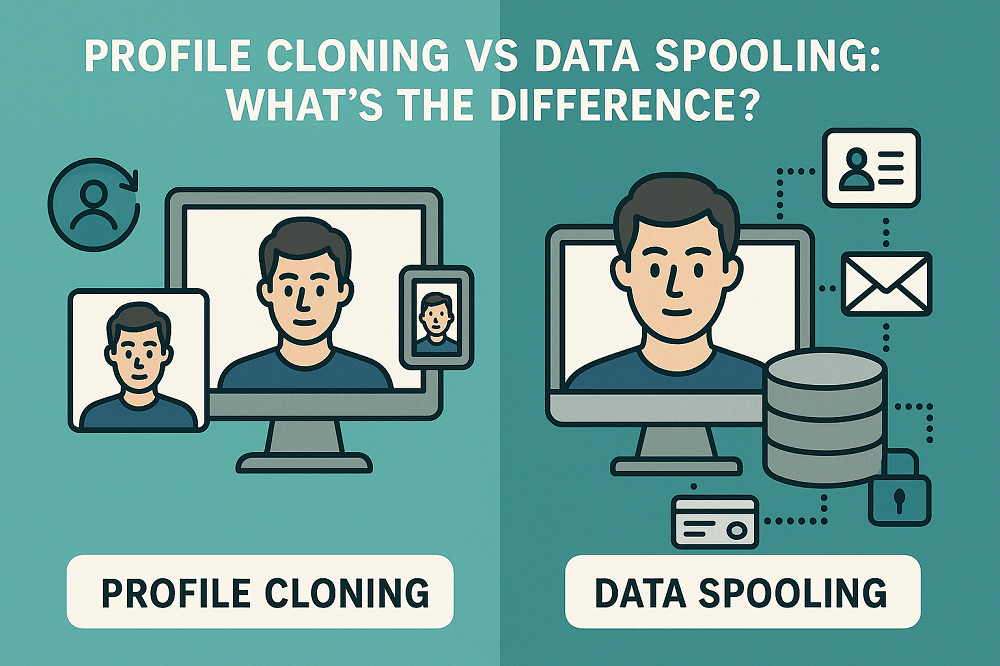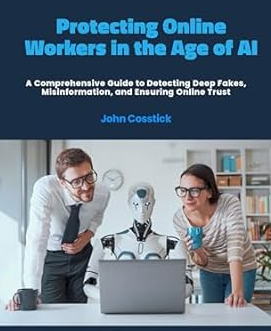Profile Cloning vs Data Spooling: Are you trying to understand data management? Let’s clear up two confusing terms: profile cloning and data spooling.
Profile cloning makes copies of user accounts for security tests or to study behavior. Data spooling helps manage data flow to keep systems running well. This guide will explain their uses, risks, and why knowing the difference is key for your data strategies.

Key Takeaways
- Profile cloning duplicates user data for testing or marketing insights.
- Data spooling optimizes data flow between servers and storage.
- Mixing the two can lead to security gaps or system slowdowns.
- Businesses use both methods to balance security and performance.
- Choosing the right approach depends on goals like testing or workflow efficiency.
Overview of Data Duplication Techniques
Online data duplication means making copies of digital info stored on networks or servers. It makes data easier to access, lowers the risk of loss, and helps keep businesses running. From simple backups to complex cloud systems, these methods help manage important information.
Defining Online Data Duplication
Online data duplication is about making copies of files, databases, or systems in different places. It’s used for disaster recovery, load balancing, and data sharing in real time. For instance, cloud services like AWS and Google Cloud use it to keep data available even when there’s an outage.
The Evolution of Data Replication Techniques
At first, data was copied using physical storage like tapes and disks. By the 2000s, network-based solutions became faster. Now, AI and automation make duplication more efficient. Key improvements include:
- Real-time database syncing
- Geo-redundant storage in the cloud
- Automated backup schedules
These advancements focus on making data management faster, safer, and more flexible.
Understanding the Core Concepts
Data replication techniques are key in today’s data management. They keep information safe and easy to reach across different systems. Let’s explore the basics to understand how they function.
- Profile cloning focuses on copying user details to mimic identities.
- Data spooling involves storing copies of data for backup or recovery.
- Replication techniques automate these processes to prevent data loss or fraud.
Think of data replication like saving a file on multiple devices. It makes copies to help recover information if needed. These methods also help find and stop unauthorized access.
Data replication isn’t just about storage—it’s a shield against disruptions.
Important terms include synchronization (keeping copies up to date) and mirroring (exact copies for quick access). Businesses use these to balance speed, cost, and security. Knowing these concepts helps protect digital information and prevent identity theft.
The Role of Identity Theft Prevention in Data Security
Protecting personal data starts with identity theft prevention. Simple steps like strong passwords and secure networks reduce risks, and organizations must prioritize these measures to prevent unauthorized access.
Importance of Personal Data Protection
Password managers and two-factor authentication are key tools. Regularly updating privacy settings on apps and social media also helps. Training teams on spotting phishing emails strengthens defenses against cyberattacks.
Digital Identity Cloning Detection Methods
- AI-driven monitoring flags unusual account activity.
- Behavioral analysis tracks patterns to detect fake profiles.
- Regular credit checks uncover unauthorized transactions.
Early detection stops fraud before it spreads. Free credit reports and fraud alerts are easy ways to stay informed.
Technical Insights: Methods and Strategies
Data security needs a blend of technical tools and planning. Encryption, access controls, and monitoring are key. Encryption makes data unreadable without the right keys. Access controls limit who can see or change information, cutting down on insider threats.
“The best data security strategies are those that adapt to evolving threats while maintaining usability,” states the National Institute of Standards and Technology (NIST).
- Encryption protocols: AES-256 and TLS protect data during storage and transit.
- Multi-factor authentication (MFA): Adds layers to login processes, blocking unauthorized access.
- Regular audits: Automated tools scan for vulnerabilities in databases and networks.
Keeping software up to date is also crucial. Old systems, like unpatched servers, leave openings for hackers. Zero-trust frameworks verify every user and device before access is granted. Cloud providers like AWS and Microsoft Azure have tools to enforce these measures.
- Encrypt all sensitive data at rest and in transit.
- Implement role-based access control (RBAC) systems.
- Intrusion detection systems (IDS) are used to monitor for suspicious patterns.
Threat modeling and AI-driven analytics are proactive steps. Companies like IBM suggest using AI to spot anomalies quickly. By combining these technical steps with training employees, organizations can create strong data security plans that keep up with cyber threats.
Profile Cloning vs Data Spooling: Head-to-Head Comparison
When we compare profile cloning and data spooling, we look at how they affect personal data protection. This helps businesses pick the best method for their needs.
Practical Applications in Different Industries
- Healthcare: Profile cloning keeps patient records safe by making copies of verified profiles. This ensures only the right people can see sensitive health info.
- Finance: Banks use data spooling to save transaction logs. This balances security with fast data recovery without showing all the data.
- Retail: Online stores use both methods. Cloning for checking who’s logged in and spooling for keeping track of stock.
Real-World Examples and Case Studies
In 2023, a study found healthcare providers cut data breaches by 40%. They did this by using profile cloning to check who’s accessing patient data.
On the other hand, a big bank’s data spooling system fixed customer accounts in minutes after a cyber attack. It did this without risking personal data protection.
Deciding between these methods depends on what your industry values most. Both are key in keeping sensitive info safe from today’s threats.
Enhancing Data Security Strategies
Protecting data is more than basic steps. Modern threats like digital identity cloning demand proactive steps. Start with layered security, focusing on real-time monitoring and educating users.
Cyber Fraud Prevention Techniques
- Implement two-factor authentication for all accounts handling sensitive data.
- Use AI-driven tools to flag unusual activity patterns linked to digital identity cloning detection.
- Train teams regularly on spotting phishing attempts and social engineering tactics.
Safeguarding Sensitive Information
Encryption is key to data protection. Sensitive records should be encrypted at rest and in transit. Use role-based permissions to limit access to authorized personnel.
Regular audits of data storage practices help spot vulnerabilities. Automated monitoring systems detect anomalies in user behavior. This is crucial for digital identity cloning detection.
Combining these tools with employee vigilance creates a strong defense. These steps help organizations stay ahead of cyber threats without making daily operations too complex.
Best Practices for Online Data Duplication
Protecting your data starts with good habits. Make sure to update your passwords often and use two-factor authentication. This helps keep hackers out. Also, keep your software up to date. Security patches fix holes that attackers might use.
- Use encryption tools for sensitive files
- Train teams to spot phishing attempts
- Limit data sharing to trusted platforms
- Monitor accounts for suspicious activity
“Data integrity depends on proactive measures, not reactive fixes,” says the FTC’s cybersecurity guide.
Turn on audit logs to track data. Set permissions based on who really needs to see it. Keep backups offline to protect against system breaches.
Regular audits by experts find and fix weak spots before they’re used by hackers. Following these steps helps prevent cyber fraud. Both small businesses and big companies can use these tips to stay safe and trusted.
Implementing Data Replication Techniques Effectively
Effective data replication needs a solid strategy to keep data safe and running smoothly. Companies must adjust their plans to meet their specific needs. This ensures they protect safeguarding sensitive information well.
Choosing the Right Method for Your Organization
Start with these steps:
- Define your goals: What data do you need to replicate, and why?
- Look at tools like AWS DataSync or Google Cloud’s Storage Transfer Service for encryption.
- Test methods in a safe space before using them fully.
Scalability and Performance Considerations
- Choose cloud-based options to grow without needing manual changes.
- Use dashboards like Datadog or New Relic to watch latency and costs.
- Set up automated backups with software like Veeam to cut down on mistakes.
Regular checks help systems keep up with changing data needs while keeping security high.
Mitigating Risks in Digital Data Management
Protecting data from threats starts with clear, actionable steps. Every organization must address vulnerabilities before they cause harm. Here’s how to build a safer digital environment:
- Perform routine security checks to find and fix weak points in systems.
- Use encryption tools to scramble sensitive data, making it unreadable to unauthorized users.
- Teach teams to spot fake emails and unsafe links through regular training sessions.
- Require two-factor authentication for all logins to block unauthorized access.
- Set up alerts for unusual data activity so issues are caught early.
These steps work best when combined into a consistent plan. Even small businesses can adopt these practices. Taking action now lowers the chance of costly breaches and keeps customer trust intact.
Future Trends in Data Cloning and Spooling
Data replication technologies are on the verge of big changes. New innovations could change how we manage digital information. Let’s dive into what’s on the horizon.
Innovations on the Horizon
Emerging tech is pushing boundaries:
- AI systems may auto-detect cloning attempts in real time.
- Blockchain-based platforms could secure data copies against tampering.
- Quantum computing might unlock faster, safer replication methods.
Emerging Threats and Opportunities
As tech advances, challenges and possibilities arise:
- Advanced AI could let hackers mimic profiles more convincingly.
- Healthcare and finance sectors may adopt cloning for secure data backups.
- New tools might help businesses protect customer info without slowing operations.
“The next five years will see a cat-and-mouse game between security teams and attackers,” says TechWatch analyst Lisa Chen. “Adaptation will be key.”
Staying ahead means watching for these shifts. The future isn’t just about blocking threats—it’s about turning innovation into an advantage.
Conclusion
Understanding profile cloning and data spooling is key to better data security. Both are risks, but knowing them helps protect sensitive info. Cybersecurity steps like encryption and audits are essential for defense.
New trends show we need to act fast. Companies like IBM and Palo Alto Networks suggest scalable solutions. These balance performance with privacy, keeping systems safe from threats.
Keeping digital identities safe is an ongoing battle. It needs constant learning and new rules. Users should check privacy settings often, and companies should train staff to spot phishing and data leaks.
As tech gets better, knowing about new tools is vital. Using blockchain or AI to detect threats is important. Following this guide helps lower cyber risks and keeps digital info safe.
Every decision today affects tomorrow’s security. Whether it’s personal accounts or business data, taking these steps helps fight off risks.
FAQ
Q1: What is the difference between profile cloning and data spooling?Profile cloning means making a fake version of someone’s digital identity. It’s used for bad things. Data spooling is when data is stored temporarily for processing. Knowing the difference helps protect data and prevent identity theft.
Q2: How can organizations safeguard against online data duplication?
To protect against online data duplication, companies should use strong data security. This includes encryption and regular checks. They should also use tools to find and stop digital identity cloning.
Q3: What data replication techniques are considered best practices?Good data replication practices include regular backups and using cloud solutions. It’s also important to check data integrity to keep sensitive info safe and ready when needed.
Q4: Why is personal data protection essential in today’s digital landscape?Protecting personal data is key to stop identity theft and cyber fraud. It keeps people’s sensitive info safe from hackers and data breaches.
Q5: What are the implications of data spooling for data management?Data spooling helps manage big data by making it easier to process. But, it needs careful watching to avoid unauthorized access and keep data safe.
Q6: How can digital identity cloning be detected?To spot digital identity cloning, watch account activity and use systems that find odd patterns. Also, set up alerts for any unusual access that might show fraud.
Q7: What strategies are effective for cyber fraud prevention?Good ways to stop cyber fraud include training employees and using multi-factor authentication. Keeping up with new cybersecurity threats and solutions also helps protect sensitive info.
Q8: How do scalability and performance impact data replication?Scalability and performance are key in data replication. They help an organization handle more data and keep it safe and accessible during busy times.
Q9: What innovations can we expect in the future of data cloning and spooling?Future advancements in data cloning and spooling might include AI for monitoring, better encryption, and new ways to manage data. These will make things more efficient and tackle new threats.















